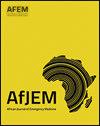Exhaled carbon monoxide concentration in correlation to clinical parameters to detect carbon monoxide poisoning among fire victims in an Egyptian Emergency Department
IF 1.2
4区 医学
Q3 EMERGENCY MEDICINE
引用次数: 0
Abstract
Background
Fire victims are at risk of inhaling potentially toxic gases contained within smoke. Carbon monoxide gas (CO) is the most significant and may contribute to morbidity and mortality of patients. Early detection of CO poisoning by measuring exhaled CO in correlation to the clinical parameters suggestive of CO poisoning in mild to moderate burn injuries among fire victims was our aim.
Methods
Case-control study involving 40 fire victims presenting with flame burn injuries within 24 h who were assessed for CO poisoning. Control group involved 40 healthy nonsmoker individuals. Exhaled CO level was measured using a CO Check Pro Device, which was correlated to clinical parameters suggestive of CO poisoning in addition to elevated lactate level.
Results
The median exhaled CO level was significantly higher in cases compared to controls (4.5 ppm vs. 1.5 ppm, p < 0.001). Among fire victims, 37.5 % had mild CO poisoning. Significant positive correlations were found between exhaled CO levels and lactate levels (r = 0.54, p < 0.001), duration of flame exposure (r = 0.59, p < 0.001), and crowding index (r = 0.49, p = 0.009).
Discussion
Exhaled carbon monoxide levels is a valuable diagnostic tool for the early detection of CO poisoning among fire victims with mild to moderate burn injuries. The correlation between elevated exhaled CO levels and clinical symptoms, alongside serum lactate level, supports their use as reliable indicator of CO exposure in fire victims, thereby optimizing emergency response strategies.
呼气一氧化碳浓度与临床参数的关系,以检测一氧化碳中毒的火灾受害者在埃及急诊科
火灾受害者有吸入烟雾中含有的潜在有毒气体的危险。一氧化碳气体(CO)是最重要的,可能导致患者的发病率和死亡率。通过测量轻中度烧伤患者呼出的一氧化碳与提示一氧化碳中毒的临床参数的相关性来早期检测一氧化碳中毒是我们的目标。方法对40例24 h内出现火焰烧伤并经一氧化碳中毒评估的火灾患者进行病例对照研究。对照组包括40名健康的非吸烟者。使用CO Check Pro设备测量呼出的CO水平,除了乳酸水平升高外,还与提示CO中毒的临床参数相关。结果与对照组相比,病例中呼出的CO水平中位数显著高于对照组(4.5 ppm对1.5 ppm, p < 0.001)。在火灾受害者中,37.5%有轻微一氧化碳中毒。呼出的CO水平与乳酸水平(r = 0.54, p < 0.001)、火焰暴露时间(r = 0.59, p < 0.001)和拥挤指数(r = 0.49, p = 0.009)之间存在显著正相关。讨论对轻中度烧伤的火灾受害者,呼气一氧化碳浓度是早期发现一氧化碳中毒的宝贵诊断工具。呼出一氧化碳水平升高与临床症状之间的相关性,以及血清乳酸水平,支持它们作为火灾受害者一氧化碳暴露的可靠指标,从而优化应急响应策略。
本文章由计算机程序翻译,如有差异,请以英文原文为准。
求助全文
约1分钟内获得全文
求助全文
来源期刊

African Journal of Emergency Medicine
EMERGENCY MEDICINE-
CiteScore
2.40
自引率
7.70%
发文量
78
审稿时长
85 days
 求助内容:
求助内容: 应助结果提醒方式:
应助结果提醒方式:


